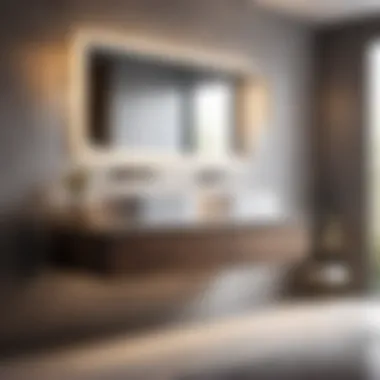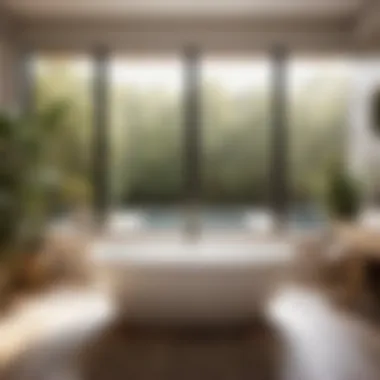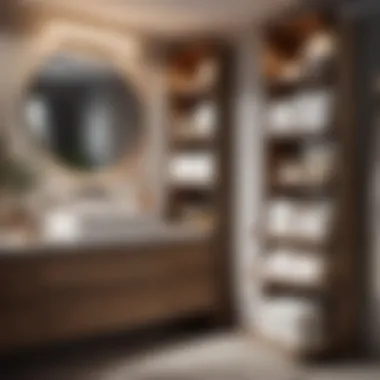Expert Guide to Mastering Your Bathroom Renovation Project


Materials:
- Tiles: 60 square feet of porcelain floor tiles, 40 square feet of subway wall tiles
- Grout: 3 bags of white grout, 2 bags of gray grout
- Vanity: 1 single sink vanity with marble top
- Faucet: 1 polished chrome sink faucet
- Lighting: 4 vanity lights, 1 ceiling light fixture
- Mirror: 1 framed mirror
- Paint: 2 gallons of semi-gloss white paint, 1 gallon of accent color paint
- Hardware: Door handles, towel bars, hooks
DIY Steps:
- Remove existing fixtures and demo old tiles carefully to avoid damaging plumbing.
- Prep the space by repairing any drywall, leveling the floor, and ensuring all plumbing lines are in good condition.
- Begin tiling from the center of the room, using spacers to maintain even grout lines.
- Install the vanity, making sure it's level and secure before connecting plumbing.
- Hang mirrors, install lighting, and paint walls for a fresh look.
Technical Aspects:
- Tools: Tile cutter, trowel, level, grout float, drill, pipe wrench
- Timing: Allow 2-3 weekends for a bathroom renovation project of this scale
- Techniques: Back butter tiles for better adhesion, use a wet saw for curved cuts
DIY Project Process:
- Lay out tiles according to the design plan, starting with floor tiles first
- Mix grout to proper consistency, applying with a grout float at a 45-degree angle
- Affix vanity to wall studs and secure plumbing connections
- Mount mirrors securely, ensuring proper lighting placement for functionality
- Apply primer before painting, using painter's tape for clean edges and professional finish
Troubleshooting Tips:
- Uneven tiles: Use a leveling system to correct discrepancies
- Leaky faucet: Check connections and tighten fittings as needed
- Paint drips: Sand gently between coats for a smooth finish
Introduction
In this article, we will explore the significance of meticulous planning in ensuring the success of your bathroom renovation. From understanding your goals and budget constraints to researching design styles and finding inspiration, the pre-planning phase plays a pivotal role in shaping the outcome of your project.
Setting clear objectives and establishing a realistic budget are the first steps towards a well-executed renovation. By defining your priorities early on, you can make informed decisions that align with your vision for the space. Additionally, researching various design styles allows you to discover what resonates with your taste and preferences, guiding the overall direction of the renovation.
Moreover, finding inspiration from various sources such as magazines, online platforms, and home improvement shows can spark creativity and ignite fresh ideas for your bathroom design. By immersing yourself in the world of design possibilities, you can refine your vision and create a cohesive aesthetic that reflects your unique style.


As we dive deeper into each subsection, you will gain valuable insights and practical tips to streamline your renovation process effectively. Stay tuned as we navigate through the essential stages of designing and executing a successful bathroom renovation, transforming your space into a sanctuary of comfort and luxury.
Pre-Planning
In the realm of bathroom renovation projects, successful outcomes often hinge on the crucial stage of pre-planning. This pivotal phase sets the tone for the entire process, laying the foundation for a seamless and well-executed renovation journey. Pre-planning involves meticulous attention to detail, strategic decision-making, and proactive preparation, all aimed at ensuring that the renovation project progresses smoothly and according to plan. By investing time and effort into pre-planning, homeowners can preempt potential pitfalls, streamline the renovation process, and achieve their desired results with efficiency.
Setting Goals and Budget
One of the primary pillars of pre-planning is establishing clear and achievable goals for the renovation project. Setting specific objectives enables homeowners to define their vision for the upgraded bathroom space, outlining the features, functionalities, and aesthetics they wish to encompass. Concurrently, establishing a realistic budget is pivotal in translating these goals into tangible action plans. By delineating a budget that aligns with their renovation goals, homeowners can navigate financial constraints, prioritize essential aspects of the project, and manage their resources effectively.
Researching Design Styles
Delving into the realm of design styles forms an integral part of pre-planning, as it allows homeowners to explore and refine their aesthetic preferences for the renovated bathroom. Researching various design styles, such as modern, minimalist, traditional, or contemporary, equips homeowners with insights into different design elements, color schemes, and decor themes that resonate with their personal taste and lifestyle. By immersing themselves in the realm of design styles, homeowners can cultivate a clear vision for their dream bathroom space and incorporate design elements that reflect their unique style and sensibilities.
Finding Inspiration
Drawing inspiration from a myriad of sources is a fundamental aspect of pre-planning that fuels creativity and innovation in the renovation process. Whether scouring interior design magazines, browsing online platforms, or visiting home improvement stores, seeking inspiration can spark ideas, ignite creativity, and inform decision-making. By curating a collection of inspirational images, color swatches, and design concepts, homeowners can refine their vision, conceptualize their ideal bathroom ambiance, and embark on the renovation journey with a sense of direction and inspiration.
Design Phase
Creating a Layout Plan
Creating a Layout Plan is a critical component of the Design Phase. This step involves mapping out the spatial arrangement of your bathroom, including the placement of fixtures, cabinetry, and other essential elements. By carefully considering factors such as traffic flow, accessibility, and design aesthetics, you can optimize the efficiency and visual appeal of your bathroom space. A well-thought-out layout plan ensures that your renovation project stays on track and aligns with your vision.
Selecting Materials and Fixtures
The selection of Materials and Fixtures is another key aspect of the Design Phase. Choosing the right materials, such as tiles, countertops, and lighting fixtures, plays a significant role in achieving the desired look and functionality of your bathroom. Factors to consider include durability, maintenance requirements, and stylistic coherence with the overall design scheme. By carefully curating materials and fixtures that complement your design aesthetic, you can create a cohesive and visually striking bathroom space.
Working with a Designer/Contractor


Collaborating with a Designer or Contractor can significantly enhance the success of your bathroom renovation project. Designers/Contractors bring a wealth of expertise and creativity to the table, helping you translate your vision into a reality. From providing design recommendations to managing the construction process, working with professionals can streamline the renovation journey and ensure a high-quality outcome. By leveraging their skills and knowledge, you can achieve a well-executed and aesthetically pleasing bathroom renovation that aligns with your expectations.
Permits and Regulations
When embarking on a bathroom renovation project, navigating the realm of permits and regulations is crucial to ensure a smooth and compliant construction process. Understanding the significance of permits and regulations not only guarantees legality but also promotes safety and quality in the project's execution.
One of the primary elements to consider in the context of permits and regulations is adherence to building codes. These codes serve as the foundation for constructing structures that meet safety standards and operational requirements. By conforming to building codes, homeowners mitigate the risks of hazards and faults in their renovated bathrooms, creating a secure environment for their families.
Moreover, obtaining necessary permits is a pivotal aspect of the renovation process. Permits grant official authorization for the proposed construction activities, ensuring that the work aligns with established guidelines. Securing these permits acts as a safeguard against potential legal violations and complications, underscoring the project's legitimacy and adherence to regulatory standards. By obtaining the required permits, homeowners demonstrate their commitment to responsible and compliant renovation practices.
In essence, permits and regulations form the regulatory framework within which a bathroom renovation project operates. By understanding and complying with these essential requirements, homeowners uphold the integrity and quality of their renovation endeavors while prioritizing safety and legal adherence.
Understanding Building Codes
Building codes constitute a set of guidelines and standards that dictate the design, construction, and maintenance of buildings. These codes encompass various aspects, including structural integrity, fire safety, plumbing, electrical systems, and accessibility. Understanding building codes is imperative during a bathroom renovation as it ensures that the newly constructed or refurbished space complies with these regulations.
Building codes aim to guarantee the safety and well-being of occupants by establishing minimum standards for structural stability and operational safety measures. As homeowners engage in renovation projects, aligning the design and construction with building codes becomes essential to create a secure and functional bathroom environment.
Obtaining Necessary Permits
Obtaining the requisite permits for a bathroom renovation project is a crucial step that cannot be overlooked. Permits serve as official consent from regulatory authorities to proceed with specific construction activities, validating that the project meets safety and quality standards. Securing these permits is essential to avoid legal repercussions and ensure compliance with local building regulations.
When acquiring permits, homeowners need to submit detailed plans and project specifications to relevant authorities for approval. This process not only guarantees compliance with building codes but also facilitates oversight and inspections to confirm that the renovations adhere to approved standards. By obtaining necessary permits, homeowners demonstrate their commitment to constructing bathrooms that prioritize safety, functionality, and compliance with regulatory frameworks.
Execution
When it comes to the execution phase of a bathroom renovation project, meticulous planning and attention to detail are crucial for ensuring a successful outcome. This section delves into the hands-on aspect of bringing your design vision to life, covering key elements that contribute to the transformation of your space.


Demolition and Removal
Demolition and removal are integral parts of the execution phase, signaling the beginning of the physical transformation process. Before new fixtures and finishes can be installed, existing elements must be carefully dismantled and removed. This stage involves precise coordination to avoid damage to surrounding structures and to ensure the safe disposal of debris. Professional expertise is often required to handle tasks such as tearing down walls, removing old tiles, and disposing of fixtures responsibly.
Plumbing and Electrical Work
The plumbing and electrical work during a bathroom renovation project is not only about functionality but also about safety. This crucial phase involves ensuring that the plumbing and electrical systems are up to code and capable of supporting the new fixtures and layout. From relocating pipes to upgrading wiring, every aspect demands precision and compliance with regulations. Hiring certified professionals for this step is advisable to prevent future issues and ensure the longevity of your renovated bathroom.
Installation of Fixtures and Finishes
The installation of fixtures and finishes is where the visual transformation of your bathroom takes place. From installing new faucets and showerheads to placing tiles and countertops, every detail contributes to the overall look and feel of the space. Proper installation techniques are essential to guarantee functionality and durability. Attention to detail is paramount, as even minor mistakes can impact the aesthetics and usability of the bathroom. Thorough inspection and quality control throughout this phase are essential to achieving a polished end result.
Final Touches
In the realm of bathroom renovation projects, the Final Touches phase is where everything comes together to create a harmonious and elegant finish. This crucial stage involves adding those small yet significant details that elevate the entire space to a new level of sophistication and functionality. Paying attention to Final Touches ensures that your bathroom renovation is complete with finesse and style, leaving no detail overlooked.
When considering Final Touches, it is important to focus on specific elements that can make a big difference in the overall ambiance of your bathroom. These elements include lighting fixtures, hardware finishes, faucets, towel racks, and mirrors. By carefully selecting and placing these items, you can enhance the aesthetic appeal and functionality of your bathroom, transforming it from ordinary to extraordinary.
One of the key benefits of prioritizing Final Touches in your bathroom renovation is the ability to personalize the space according to your taste and preferences. Adding decorative elements that reflect your style can make the bathroom feel like a true extension of your personality and create a welcoming atmosphere for both residents and guests.
Moreover, considering practical aspects such as storage solutions and organizational tools during the Final Touches phase can improve the usability of the space and enhance its convenience. By paying attention to these details, you can optimize the functionality of your renovated bathroom while maintaining a sense of elegance and luxury.
During the Final Touches phase, it is essential to take into account various considerations to ensure a successful outcome. Factors such as color coordination, material quality, and spatial arrangement play a critical role in achieving a cohesive and visually appealing finish. By integrating these considerations thoughtfully, you can create a truly stunning bathroom that is both aesthetically pleasing and highly functional.
Conclusion
In the realm of bathroom renovation project planning, the conclusion serves as the culmination of meticulous efforts and detailed considerations. It plays a pivotal role in ensuring a successful and satisfying outcome for homeowners embarking on this transformative journey. As we draw the curtain on this ultimate guide, it is imperative to reflect on the key elements that make the conclusion a critical aspect of the entire process.
One of the paramount considerations in the conclusion stage is quality inspection. This crucial step involves a comprehensive evaluation of the renovation work to guarantee that every aspect meets the desired standards. From plumbing fixtures to the aesthetic appeal of the space, a thorough inspection ensures that all elements align with the initial vision and objectives of the project. By prioritizing quality inspection in the conclusion phase, homeowners can rest assured that their investment in the renovation yields a space that is not just visually stunning but also functional and durable.
Moreover, the conclusion phase encapsulates the satisfaction of witnessing the fruition of meticulous planning and diligent execution. It marks the moment when homeowners can bask in the beauty and functionality of their newly renovated bathroom. The sense of accomplishment and pride that comes with stepping into a revitalized space is unparalleled, making the conclusion an immensely fulfilling stage in the renovation journey.
Beyond the tangible aspects, the conclusion also signifies a new chapter in the homeowners' living experience. A well-executed bathroom renovation can elevate the comfort and aesthetics of the home, creating a sanctuary within the living space. It offers a retreat from the demands of daily life, allowing homeowners to unwind and rejuvenate in a personalized oasis that reflects their style and preferences.
For those embarking on a bathroom renovation project, the conclusion represents not just the end of a process but the beginning of a new relationship with their living environment. It embodies the essence of transformation and renewal, enriching the daily lives of individuals and families. The conclusion is where dreams manifest into reality, where visions materialize into tangible spaces that enhance both the form and function of the home.







